
The White Flower Day charity festival was a charity fundraising event that took place especially in the Russian Empire between 1911 and 1917 (but also in other northern European countries), usually in spring time.

The White Flower Day charity festival was a charity fundraising event that took place especially in the Russian Empire between 1911 and 1917 (but also in other northern European countries), usually in spring time.
First introduced in Sweden at the beginning of the 20th century and immediately appreciated by the Tsar Nicholas II of Russia and especially by his wife, the empress Alexandra Feodorovna, it was held for the first time in the spring 1911. [1] [2] [3] Mainly focused on helping people with the tuberculosis disease, it saw many people of all class in April and May of every year going around in towns and villages, selling white flowers (usually paper-reproductions of the Matricaria chamomilla or the Leucanthemum vulgare ).
The inner family of Nicholas II also attended it in the years just before the outbreak of the Great War: [4] all of them instated a great bazar in Livadiya (especially at the Livadia Palace, the local royal residence in spring time, in Crimea), selling hand-made things, while the daughters of the tsar, commonly known as OTMA, went through the streets of the towns of Livadiya and Yalta - especially near the harbor - in 1912 and 1914 to further gather money for the charity cause. [5]
After the 1917 the charity event was not held anymore, until it was revived in the 21st century. [2] [6]

Maria Feodorovna, known before her marriage as Princess Dagmar of Denmark, was Empress of Russia from 1881 to 1894 as the wife of Emperor Alexander III. She was the fourth child and second daughter of Christian IX of Denmark and Louise of Hesse-Kassel. Maria’s eldest son, Nicholas, was the last Emperor of Russia, ruling from 1 November 1894 until his abdication on 15 March 1917. Maria lived for 10 years after Bolshevik functionaries killed Nicholas and his immediate family in 1918.

Alexandra Feodorovna, born Princess Alix of Hesse and by Rhine, was the last Empress of Russia as the consort of Tsar Nicholas II from their marriage on 26 November [O.S. 14 November] 1894 until his forced abdication on 15 March [O.S. 2 March] 1917. A granddaughter of Queen Victoria, Alexandra was one of the most famous royal carriers of hemophilia and passed the condition to her son, Alexei Nikolaevich, Tsarevich of Russia.

Grand Duchess Tatiana Nikolaevna of Russia was the second daughter of Tsar Nicholas II, the last monarch of Russia, and of Tsarina Alexandra. She was born at Peterhof Palace, near Saint Petersburg.

Grand Duchess Anastasia Nikolaevna of Russia was the youngest daughter of Tsar Nicholas II, the last sovereign of Imperial Russia, and his wife, Tsarina Alexandra Feodorovna.

Yalta is a resort city on the south coast of the Crimean Peninsula surrounded by the Black Sea. It serves as the administrative center of Yalta Municipality, one of the regions within Crimea. Yalta, along with the rest of Crimea, is internationally recognised as part of Ukraine, and is considered part of the Autonomous Republic of Crimea. However, it is under the control of Russia, which annexed Crimea in 2014 and regards the town as part of the Republic of Crimea. According to the most recent census, its population was 76,746 .
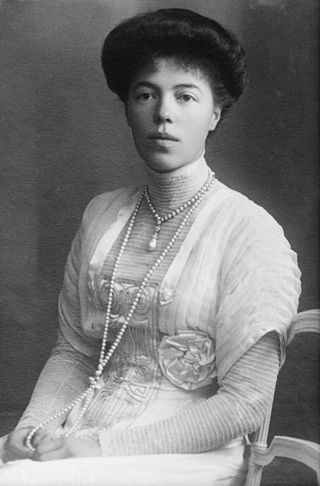
Grand Duchess Olga Alexandrovna of Russia was the youngest child of Emperor Alexander III of Russia and younger sister of Emperor Nicholas II.
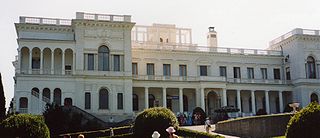
Livadiya is an urban-type settlement in Crimea. It is located 3 kilometres (1.9 mi) west of Yalta. Population: 1,074 .

Maria Alexandrovna, born Princess Wilhelmine Marie of Hesse and by Rhine, was Empress of Russia as the first wife of Emperor Alexander II.
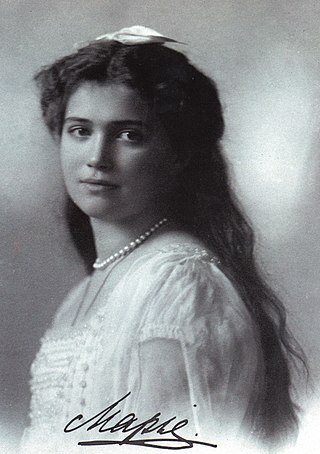
Grand Duchess Maria Nikolaevna of Russia was the third daughter of Tsar Nicholas II of Russia and Tsarina Alexandra Feodorovna. Her murder following the Russian Revolution of 1917 resulted in her canonization as a passion bearer by the Russian Orthodox Church.

Livadia Palace is a former summer retreat of the last Russian tsar, Nicholas II, and his family in Livadiya, Crimea. The Yalta Conference was held there in 1945, when the palace housed the apartments of Franklin Delano Roosevelt and other members of the American delegation – the Soviet delegation was housed in the Yusupov Palace, and the British in the Vorontsov Palace some eight kilometers distant. The palace houses a museum, and is sometimes used for international summits.

OTMA was an acronym sometimes used by the four daughters of Emperor Nicholas II of Russia and his consort, Alexandra Feodorovna, as a group nickname for themselves, built from the first letter of each girl's name in the order of their births:

Princess Anastasia Petrović-Njegoš of Montenegro was the daughter of King Nikola I Petrović-Njegoš of Montenegro (1841–1921) and his wife, Queen Milena (1847–1923). Through her second marriage, she became Grand Duchess Anastasia Nikolaevna Romanova of Russia. She and her sister "Militza", having married Russian royal brothers, were known colloquially as the "Montenegrin princesses" during the last days of Imperial Russia, and may have contributed to its downfall by the introduction of Grigori Rasputin to the Empress Alexandra.
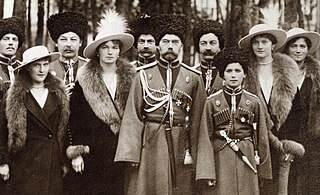
Members of the ruling Russian imperial family, the House of Romanov, were executed by a firing squad led by Yakov Yurovsky in Yekaterinburg, Russia, on July 17, 1918, during both the Russian Civil War and near the end of the First World War.

The Red Cross with Imperial portraits egg is a jewelled and enameled Easter egg made by Henrik Wigström (1862–1923) under the supervision of the Russian jeweller Peter Carl Fabergé in 1915, for Nicholas II of Russia, who presented the Fabergé egg to his mother, the Dowager Empress Maria Feodorovna, in the same year.

The Romanovs: An Imperial Family is a 2000 Russian historical drama film about the last days of Tsar Nicholas II and his family. The Russian title implies both the Imperial Crown of Russia and the crown of thorns associated with martyrs. The film premiered at the 22nd annual Moscow Film Festival. The film was selected as the Russian entry for the Best Foreign Language Film at the 76th Academy Awards, but it didn't make the final shortlist.

The Mosaic egg is a jewelled enameled Easter egg made under the supervision of the Russian jeweller Peter Carl Fabergé in 1914. The Fabergé egg was made for Nicholas II of Russia, who presented it to his wife, the Empress Alexandra Feodorovna on Easter 1914. Its Easter 1914 counterpart is the Catherine the Great egg.

Grand Duchess Olga Nikolaevna of Russia was the eldest child of the last Russian emperor, Nicholas II, and of his wife Alexandra.

Anastasia is a musical play with music and lyrics by Lynn Ahrens and Stephen Flaherty, and a book by Terrence McNally. Based on the 20th Century Fox Animation 1997 film of the same name, the musical adapts the legend of the Grand Duchess Anastasia Nikolaevna of Russia, who was rumored to have escaped and survived the execution of the Russian Imperial family. Many years later, an amnesiac young woman named Anya hopes to find some trace of her past by siding with two con men, who wish to take advantage of her resemblance to Anastasia.

Alexandra Alexandrovna Tegleva, also known as Shura Tegleva and Sasha Tegleva, was a Russian noblewoman who served as a nursemaid in the Russian Imperial Household. As nursemaid to the children of Emperor Nicholas II and Empress Alexandra Feodorovna, she went with the family into exile in Tobolsk following the abdication of Nicholas II during the February Revolution, but was ultimately prevented from staying with them during their house arrest at Ipatiev House. She survived the Russian Revolution and married Pierre Gilliard, a Swiss academic who served with her in the Imperial Household as the children's French tutor. She moved to Lausanne as a white émigré and remained there the rest of her life. Tegleva worked with her husband to investigate and debunk the claims made by Anna Anderson, a Romanov impostor who pretended to be Grand Duchess Anastasia Nikolaevna.
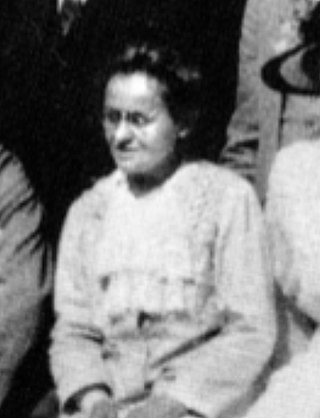
Elizaveta Nikolaevna "Liza" Ersberg was a German-Russian parlormaid who served in the Russian Imperial Household. The daughter of a stoker employed by Emperor Alexander III, she was hired by Empress Maria Feodorovna as a parlormaid at the Alexander Palace in 1898. She used her post to obtain a position at court for her friend Anna Demidova, who became a lady-in-waiting to Empress Alexandra Feodorovna.
19th April. Saturday. At 11 o'clock, we 5 with Mama (in her carriage), Anya and Iza went to Livadia to sell white flowers. Saw Yuzik. This was in favor of children with tuberculosis. Had breakfast with everyone. From Yacht N.P., Kazhevnikov (both were at tennis) Taube and Serg. Vas. After Anastasia, Iza and I went to sell flowers. Lots of soldiers. Arrived for tennis. Played 5 sets with N. N. against Papa and Anya. We won three, they won two. It was very good. Drank tea together. We're at church. Had dinner with our suite. (1914 Diary of Grand Duchess Tatiana Nikolaevna)